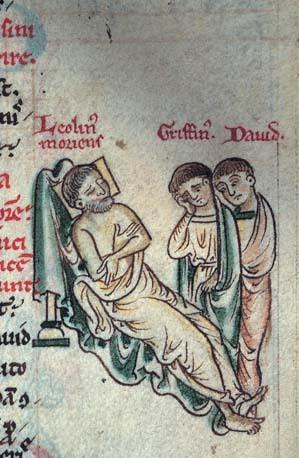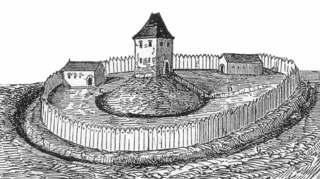
Llywelyn ap Gruffudd, sometimes written as Llywelyn ap Gruffydd, also known as Llywelyn the Last, was the native Prince of Wales from 1258 until his death at Cilmeri in 1282. Llywelyn was the son of Gruffydd ap Llywelyn Fawr and grandson of Llywelyn the Great, and he was one of the last native and independent princes of Wales before its conquest by Edward I of England and English rule in Wales that followed, until Owain Glyndŵr held the title during the Welsh Revolt of 1400–1415.

Llywelyn ab Iorwerth, also known as Llywelyn the Great was a medieval Welsh ruler. He succeeded his uncle, Dafydd ab Owain Gwynedd, as prince of Gwynedd in 1195 and became prince of Powys Wenwynwyn in 1216. By a combination of war and diplomacy he dominated Wales for 45 years.

Gwenwynwyn ab Owain Cyfeiliog was the last major ruler of mid Wales before the completion of the Norman English invasion. He was one of few native rulers to represent a real threat to the rule of Llywelyn the Great.

The Kingdom of Powys was a Welsh successor state, petty kingdom and principality that emerged during the Middle Ages following the end of Roman rule in Britain. It very roughly covered the northern two-thirds of the modern county of Powys and part of today's English West Midlands. More precisely, and based on the Romano-British tribal lands of the Ordovices in the west and the Cornovii in the east, its boundaries originally extended from the Cambrian Mountains in the west to include the modern West Midlands region of England in the east. The fertile river valleys of the Severn and Tern are found here, and this region is referred to in later Welsh literature as "the Paradise of Powys".
Maelgwn ap Rhys was prince of part of the kingdom of Deheubarth in south west Wales.

Powys Wenwynwyn or Powys Cyfeiliog was a Welsh kingdom which existed during the high Middle Ages. The realm was the southern portion of the former princely state of Powys which split following the death of Madog ap Maredudd of Powys in 1160: the northern portion (Maelor) went to Gruffydd Maelor and eventually became known as Powys Fadog; while the southern portion (Cyfeiliog) going to Owain Cyfeiliog and becoming known, eventually, as Powys Wenwynwyn after Prince Gwenwynwyn ab Owain, its second ruler.
Gruffydd ap Gwenwynwyn was a Welsh king who was lord of the part of Powys known as Powys Wenwynwyn and sided with Edward I in his conquest of Wales of 1277 to 1283.
Sir Gruffudd Vychan, also spelt in English sources as Griffith Vaughan, was a Welsh knight who supported the rebellion of Prince Owain Glyndŵr against the English, and captured the Lollard John Oldcastle, who was later immortalized by Shakespeare as John Falstaff. He was finally executed after the murder of Sir Christopher Talbot, son of John Talbot, 1st Earl of Shrewsbury.

Gwrtheyrnion or Gwerthrynion was a commote in medieval Wales, located in Mid Wales on the north side of the River Wye; its historical centre was Rhayader. It is said to have taken its name from the legendary king Vortigern. For most of the medieval era, it was associated with the cantref of Buellt and then Elfael, small regional kingdoms whose rulers operated independently of other powers. In the Norman era, like the rest of the region between Wye and Severn it came to be dominated by Marcher Lordships.
This article is about the particular significance of the century 1201–1300 to Wales and its people.

Wales in the High Middle Ages covers the 11th to 13th centuries in Welsh history. Beginning shortly before the Norman invasion of the 1060s and ending with the Conquest of Wales by Edward I between 1278 and 1283, it was a period of significant political, cultural and social change for the country.

The history of Gwynedd in the High Middle Ages is a period in the History of Wales spanning the 11th through the 13th centuries. Gwynedd, located in the north of Wales, eventually became the most dominant of Welsh polities during this period. Contact with continental courts allowed for Gwynedd to transition from a petty kingdom into an increasingly sophisticated principality of seasoned courtiers capable of high level deplomacy and representation; not only with the Angevine kings, but also the king of France and the Papal See. Distinctive achievements in Gwynedd include further development of Medieval Welsh literature, particularly poets known as the Beirdd y Tywysogion associated with the court of Gwynedd; the reformation of bardic schools; and the continued development of Cyfraith Hywel. All three of these further contributed to the development of a Welsh national identity in the face of Anglo-Norman encroachment of Wales.

Arwystli was a cantref in mid Wales in the Middle Ages, located in the headland of the River Severn. It was chiefly associated with the Kingdom of Powys, but was heavily disputed between Powys, Gwynedd, and the Norman Marcher Lords for hundreds of years, and was the scene of many skirmishes between those groups. Like many other cantrefs and subdivisions, it was divided up by the Laws in Wales Acts in the 16th century.

Ystrad Marchell was a medieval commote in the cantref of Ystlyg in the Kingdom of Powys. It roughly coincides with the parish of Welshpool.

Ystlyg was a medieval cantref in the Kingdom of Powys. It lay at the east of the kingdom on the border with England. It consisted of the commotes (cymydau) of Deuddwr in the north, Ystrad Marchell in the centre, Llannerch Hudol in the south, and Y Gorddwr in the east beyond the River Severn and Offa's Dyke.

Deuddwr was a medieval commote (cwmwd) in the cantref of Ystlyg in the Kingdom of Powys.

Llanerchydol is a hamlet in Powys, Wales, situated on the A458 about 2 km west of the centre of Welshpool. It is part of the community of Welshpool and also lends its name to an electoral ward of Welshpool Llanerchyddol.

Tomen yr Allt was a Medieval motte and bailey defensive castle near Llanfyllin in Powys, Wales. "Tomen ar hallt" is modern Welsh for "mound on the wooded hillside."
Hawise Lestrange was the daughter of the Marcher lord John Lestrange (d.1269) of Great Ness, Cheswardine and Knockin (Shropshire). Married at a young age to the ruler of southern Powys, Gruffudd ap Gwenwynwyn, she became a key figure in border affairs and in the management of her family and estates until her death at a great age. She was deeply implicated in a plot to overthrow the prince of Wales, Llywelyn ap Gruffudd, in 1274, and with her husband sided with Edward I in the English king's conquest of Wales.

Fulk FitzWarin, 1st Baron FitzWarin, sometimes styled as Fulk V FitzWarin, was an English landowner and soldier who was created the first Baron FitzWarin in 1295, during the reign of King Edward I.











